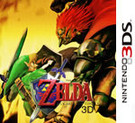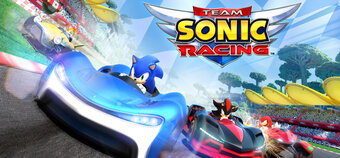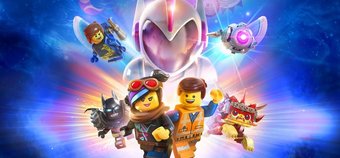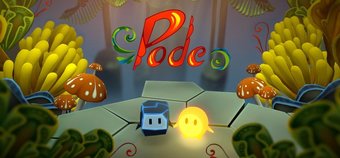Ocarina of Time originally came out on the N64 in 1998. 13 years on, the entire first half of the game remains fresh in my mind. It's a testament to just how brilliant the game was. Or at least a testament to how obsessively my 8-year old self played it.
Either way, it was a masterpiece back then, so it's little wonder Nintendo decided to remake Ocarina of Time as the flagship game for their new handheld. Having completely redone the visuals and added 3D to the world, this isn't just a rushed-out cash-in, it's the game to showcase exactly what their new machine is capable of.
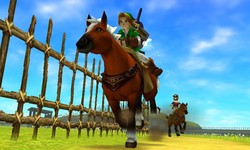
Oh, and you can befriend horses. Did we mention horses?
If you've never played Ocarina of Time before, it places you in the elf-y boots of Link, a young forest boy without a fairy who learns of the evil Gannodorf's plot to take control of the land of Hyrule by capturing the Triforce (an ancient relic left by the Goddesses, said to grant the wishes of whoever holds it). Not wanting to let the world fall into the hands of evil, he leaves the forest behind and sets out to stop Gannondorf. It's the kind of thing you'd read in a fairytale: Young orphan boy leaves home to become mighty swordsman and save the world from evil ginger-haired sorcerer, befriending princesses, owls and ghosts along the way. There's even a sword in the stone thrown in for good measure.
The game begins with Link getting a visit from a fairy, telling him that he's been summoned by The Great Deku Tree, the guardian of the forest he and his Kokiri brethren live in. Unfortunately, to get to the Great Deku Tree, Link has to get past his jobsworth rival, Mido, who won't allow him through to the Great Deku Tree's grove without a sword and shield. Luckily, this gives you the perfect excuse to look around the forest and get to grips with the controls.
The original Ocarina of Time was the first 3D Zelda game (previous games on the NES/SNES had been top down/side-scrolling adventure games), and with it, it introduced Z-Targeting (which became L-Targeting in every subsequent game - Same function, they just changed the button you pressed to use it). This allowed you to click a button and lock onto a character, enemy, or even a bush and move around while keeping the target constantly in the centre of the screen, allowing you to hack away like a madman without ever letting it out of your sight. For those who have difficulty controlling the camera separately, it's an incredibly useful feature. The rest of the controls are relatively standard, use the circle pad to move, B to attack, A to talk, and X and Y (along with the (I and II "buttons" on the touchscreen) are item shortcuts, which can be assigned by the inventory tab on the touchscreen. With the shield being assigned to the R button, the X, Y and Z layout the other games have used isn't possible with the 3DS, but with the ability to shortcut up to 4 items now, we're not complaining. The touchscreen also comes in handy for changing weapons and clothes, and all the faffing about you might remember doing in the Water Temple changing into the Iron Boots has now been completely removed, as they're an equip-able item now, much like in Twilight Princess. You'd be amazed how much time it saves.

The Water Temple. Previously more frustrating than assembling a 20,000 piece jigsaw of clear blue sky. Now it's a walk in the park.
Essentially, the search for a sword and shield acts as a disguised tutorial for the game. Once you've found them you'll have had to utilise the vast majority of the controls (jumping, crawling, swordfighting, etc) as well as talking to people and using the shop. And you probably didn't even notice you were learning!
Sword and shield in hand, it's time to see what Zelda's really about - The dungeons. If this is your first Zelda experience (and if it is, you're a lucky pup), the dungeons are essentially a maze of puzzles that sees you fighting from room to room in an attempt to reach the Dungeon's "boss". While the puzzles in the early dungeons are simply "push block here > Climb on top of it" style puzzles, later dungeons offer much more testing trials, including rotating corridors, invisible floors, and even travelling through time to open up the path to the boss. But if you're a hardened Zelda veteran who's seen it all before and wants a new challenge, then you're in luck, as the game also features a brand new Master Quest mode. Based on the original Master Quest (a version of Ocarina of Time released on the ill-fated Nintendo 64DD that featured tougher, shaken up dungeons), the 3DS version of Master Quest as well as featuring the newly laid out dungeons also features a completely mirrored Hyrule along with harder enemies (and to try and prove how hard it is, it's only accessible once you've finished the game).
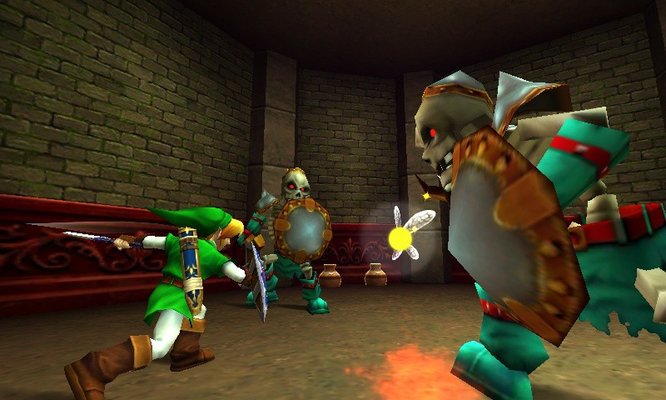
In the Master Quest, enemies do twice as much damage. Only the brave need apply.
The Master Quest mode isn't the only new addition to Ocarina of Time 3D, as it also now includes a rather nifty gyroscope aiming mode, making use of the 3DS's motion controls. When you aim a slightshot, bow, or hookshot, as well as being able to aim using the circle pad, you can hold your arms out (as if holding a slingshot, bow, or hookshot) and move the 3DS around at arms length to aim. It's difficult to explain, but it actually works shockingly well (as long as you're alone. We don't advise using the motion controls on the train, you'll look a plank). There's also a Boss Rush mode included, which sees you facing off against every boss in the game one after the other in the quickest time possible, so there's no shortage of stuff crammed into that tiny cartridge. It's quite a feat, when you consider just how large the game is.
In typical Zelda style there's an enormous amount of side-quests you can undertake if you're bored of the dungeons, ranging from the relatively simple "go here, do this" variety of quest, to collect-a-thons that span the entire length of the game (and more!). Early on in the game, you'll find a woman in Kakariko village who's lost all of her Cucoos (the Hyrule version of a Chicken), and as she's allergic to them, she can't go and catch them herself. Catch all the Cuccoos and you net yourself a bottle, which comes in handy for storing stuff in. Good deeds in Zelda rarely go unrewarded, with the sidequests that don't give you important items getting you money or heart pieces instead (collect enough heart pieces and you'll gain another heart, letting you take more damage before it's Game Over).
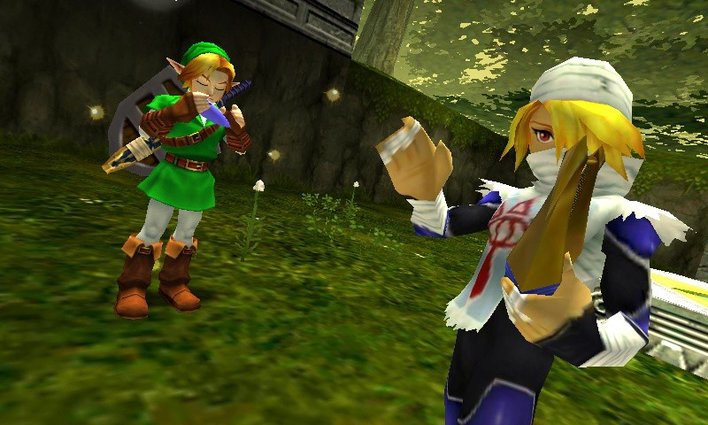
If there's one thing Ocarina of Time is really missing, it's an open-mic night minigame.
In case you were wondering, the Ocarina in the name is a reference to the flute-like instrument, because (as well as being pretty darn good at just about everything else) Link is a rather handy musician. As you progress through the game you'll learn songs, which you can play (using the triggers and the 3DS's face button) for a variety of effects. If you head to the ranch in the middle of Hyrule field you'll meet a girl humming a dainty tune to her horse. At first, the horse appears to be afraid of other people, as it runs away as soon as you go near it. Whip your Ocarina out in front of the girl and she'll teach you the song she's humming, which just so happens to be the horse's favourite tune, forming an unbreakable bond between man and machine. Well, man and horse. Later on in the game, you'll be able to beckon your horse to your side at will by just playing the song. There are other other useful songs you can learn, too that allow you to turn day into night and teleport you to key locations around Hyrule, amongst other things.
Ocarina of Time has been topping an awful lot of Best Game Ever lists since it came out, so it's only fitting that the 3DS version just so happens to be the best game on the handheld. While that isn't really an impressive feat at the moment, we can't see it being knocked off for some time. There's just so much crammed into that tiny cartridge it's unbelievable. If you haven't already bought it, get out there and buy it right now, regardless of whether or not you've played the original, it really is that good. And if you haven't played the original, then there's an awful lot of people out there who are jealous of you right about now.
And come on, Nintendo. Give us Majora's Mask now you've done this one, please?
Format Reviewed: Nintendo 3DS


